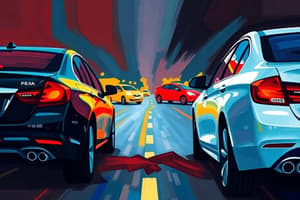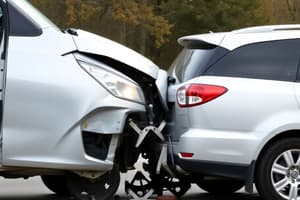Podcast
Questions and Answers
In what types of weather do most collisions occur?
In what types of weather do most collisions occur?
Most crashes occur in nice weather.
Besides other cars, with what or with whom do we share the road?
Besides other cars, with what or with whom do we share the road?
Buses, motorcycles, trucks, bicycles, pedestrians, etc.
What must you do when you see a stopped school bus with its red lights flashing?
What must you do when you see a stopped school bus with its red lights flashing?
Stop.
Who has the right-of-way at a four-way stop?
Who has the right-of-way at a four-way stop?
What must you do when you hear or see an emergency vehicle approaching?
What must you do when you hear or see an emergency vehicle approaching?
List as many distractions as you can that may cause a collision.
List as many distractions as you can that may cause a collision.
What is defensive driving?
What is defensive driving?
How does one become a good defensive driver?
How does one become a good defensive driver?
What is an average driver's reaction time?
What is an average driver's reaction time?
To what does the term 2-second rule refer?
To what does the term 2-second rule refer?
Flashcards are hidden until you start studying
Study Notes
Collision Statistics
- Most collisions occur in nice weather, despite a concentration of crashes during freezing rain, sleet, or snow.
Sharing the Road
- Road users include buses, motorcycles, trucks, bicycles, pedestrians, delivery vehicles, and taxicabs.
Stopped School Buses
- Always stop for a school bus with flashing red lights, regardless of direction or lane configuration, unless on a divided highway with a physical barrier of at least five feet.
Right-of-Way at Four-Way Stops
- Right-of-way must be given, not taken; no driver has inherent right-of-way, and caution should be exercised.
Emergency Vehicles
- Yield to emergency vehicles that display audible or visible signals; pull over to the curb and stop until the vehicle has passed, following directions from law enforcement if present.
Distractions Leading to Collisions
- Distractions are a leading cause of U.S. collisions; over 90% of crash-causing drivers were under emotional stress or distracted before the incident.
Defensive Driving Defined
- Defensive Driving involves using the correct attitudes, skills, and knowledge to avoid accidents and confrontations on the road.
Becoming a Good Defensive Driver
- Good defensive driving is achieved through observation, driving skills improvement, knowledge of new rules, and prioritizing safe driving; acronym SIPDE: Scan, Identify, Predict, Decide, Execute.
Average Driver's Reaction Time
- The average reaction time for drivers is between 1 to 1.5 seconds, contrasting with the clinical setting time of 3/4 of a second.
Two-Second Rule
- The Two-Second Rule helps maintain safe following distance: choose a fixed object and start counting when the car in front passes it; if you reach it before counting to two, increase following distance.
Studying That Suits You
Use AI to generate personalized quizzes and flashcards to suit your learning preferences.




